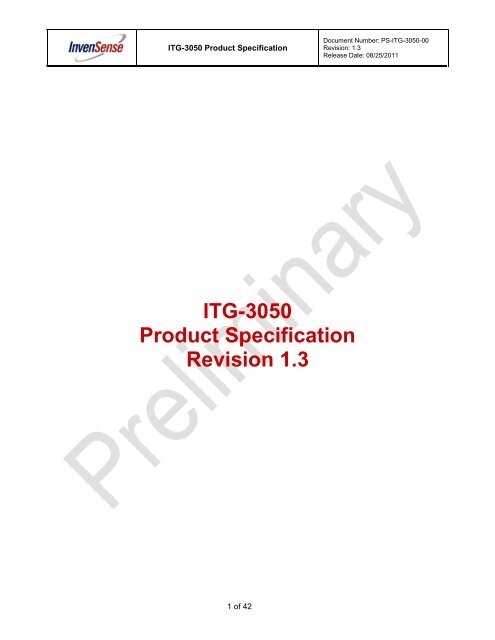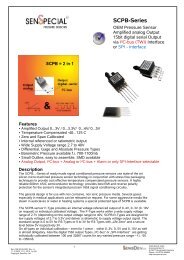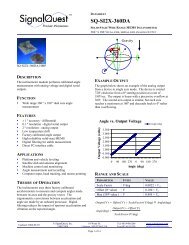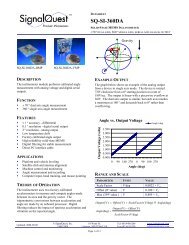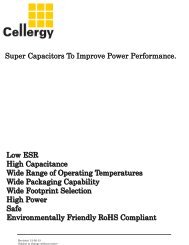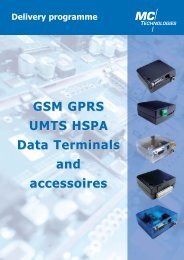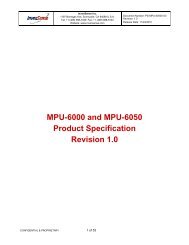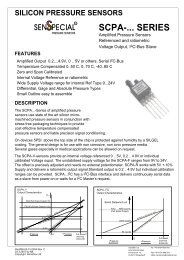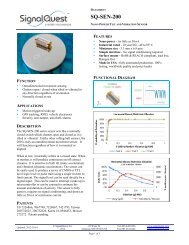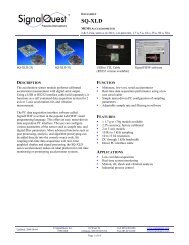ITG-3050 Product Specification Revision 1.3 - InvenSense
ITG-3050 Product Specification Revision 1.3 - InvenSense
ITG-3050 Product Specification Revision 1.3 - InvenSense
Create successful ePaper yourself
Turn your PDF publications into a flip-book with our unique Google optimized e-Paper software.
<strong>ITG</strong>-<strong>3050</strong> <strong>Product</strong> <strong>Specification</strong><br />
Document Number: PS-<strong>ITG</strong>-<strong>3050</strong>-00<br />
<strong>Revision</strong>: <strong>1.3</strong><br />
Release Date: 08/25/2011<br />
<strong>ITG</strong>-<strong>3050</strong><br />
<strong>Product</strong> <strong>Specification</strong><br />
<strong>Revision</strong> <strong>1.3</strong><br />
1 of 42
<strong>ITG</strong>-<strong>3050</strong> <strong>Product</strong> <strong>Specification</strong><br />
Document Number: PS-<strong>ITG</strong>-<strong>3050</strong>-00<br />
<strong>Revision</strong>: <strong>1.3</strong><br />
Release Date: 08/25/2011<br />
CONTENTS<br />
1 DOCUMENT INFORMATION ..................................................................................................................... 4<br />
1.1 REVISION HISTORY ................................................................................................................................. 4<br />
1.2 PURPOSE AND SCOPE ............................................................................................................................ 5<br />
<strong>1.3</strong> PRODUCT OVERVIEW.............................................................................................................................. 5<br />
1.4 SOFTWARE SOLUTIONS .......................................................................................................................... 5<br />
1.5 APPLICATIONS ........................................................................................................................................ 7<br />
2 FEATURES ................................................................................................................................................. 8<br />
2.1 SENSORS ............................................................................................................................................... 8<br />
2.2 DIGITAL OUTPUT .................................................................................................................................... 8<br />
2.3 DATA PROCESSING ................................................................................................................................ 8<br />
2.4 CLOCKING .............................................................................................................................................. 8<br />
2.5 POWER .................................................................................................................................................. 8<br />
2.6 PACKAGE ............................................................................................................................................... 8<br />
3 ELECTRICAL CHARACTERISTICS .......................................................................................................... 9<br />
3.1 SENSOR SPECIFICATIONS ....................................................................................................................... 9<br />
3.2 ELECTRICAL SPECIFICATIONS................................................................................................................ 10<br />
3.3 ELECTRICAL SPECIFICATIONS, CONTINUED ............................................................................................ 11<br />
3.4 ELECTRICAL SPECIFICATIONS, CONTINUED ............................................................................................ 12<br />
3.5 I 2 C TIMING CHARACTERIZATION ............................................................................................................ 13<br />
3.6 ABSOLUTE MAXIMUM RATINGS .............................................................................................................. 14<br />
4 APPLICATIONS INFORMATION ............................................................................................................. 15<br />
4.1 PIN OUT AND SIGNAL DESCRIPTION ....................................................................................................... 15<br />
4.2 TYPICAL OPERATING CIRCUIT ............................................................................................................... 16<br />
4.3 BILL OF MATERIALS FOR EXTERNAL COMPONENTS ................................................................................. 16<br />
4.4 RECOMMENDED POWER-ON PROCEDURE .............................................................................................. 17<br />
5 FUNCTIONAL OVERVIEW ....................................................................................................................... 18<br />
5.1 BLOCK DIAGRAM .................................................................................................................................. 18<br />
5.2 OVERVIEW ........................................................................................................................................... 18<br />
5.3 THREE-AXIS MEMS GYROSCOPE WITH 16-BIT ADCS AND SIGNAL CONDITIONING .................................. 18<br />
5.4 PRIMARY I 2 C SERIAL COMMUNICATIONS INTERFACE............................................................................... 19<br />
5.5 SECONDARY I 2 C SERIAL INTERFACE (FOR 3 RD -PARTY ACCELEROMETERS) ............................................... 19<br />
5.6 3 RD PARTY ACCELEROMETER CIRCUIT CONFIGURATIONS ........................................................................ 22<br />
5.7 INTERNAL CLOCK GENERATION ............................................................................................................. 22<br />
5.8 CLOCK OUTPUT .................................................................................................................................... 23<br />
5.9 SENSOR DATA REGISTERS ................................................................................................................... 23<br />
5.10 FIFO ................................................................................................................................................... 23<br />
5.11 INTERRUPTS ......................................................................................................................................... 23<br />
5.12 DIGITAL-OUTPUT TEMPERATURE SENSOR ............................................................................................. 23<br />
5.13 BIAS AND LDO ..................................................................................................................................... 23<br />
5.14 CHARGE PUMP ..................................................................................................................................... 23<br />
6 DIGITAL INTERFACE ............................................................................................................................... 24<br />
6.1 I 2 C SERIAL INTERFACE ......................................................................................................................... 24<br />
7 SERIAL INTERFACE CONSIDERATIONS .............................................................................................. 28<br />
7.1 <strong>ITG</strong>-<strong>3050</strong> SUPPORTED INTERFACES ..................................................................................................... 28<br />
7.2 LOGIC LEVELS ...................................................................................................................................... 28<br />
8 ASSEMBLY ............................................................................................................................................... 31<br />
2 of 42
<strong>ITG</strong>-<strong>3050</strong> <strong>Product</strong> <strong>Specification</strong><br />
Document Number: PS-<strong>ITG</strong>-<strong>3050</strong>-00<br />
<strong>Revision</strong>: <strong>1.3</strong><br />
Release Date: 08/25/2011<br />
8.1 ORIENTATION OF AXES ......................................................................................................................... 31<br />
8.2 PACKAGE DIMENSIONS: ........................................................................................................................ 32<br />
8.3 PCB DESIGN GUIDELINES:.................................................................................................................... 33<br />
8.4 ASSEMBLY PRECAUTIONS ..................................................................................................................... 34<br />
8.5 PACKAGE MARKING SPECIFICATION ...................................................................................................... 37<br />
8.6 TAPE & REEL SPECIFICATION ................................................................................................................ 38<br />
8.7 LABEL .................................................................................................................................................. 39<br />
8.8 PACKAGING .......................................................................................................................................... 40<br />
9 RELIABILITY ............................................................................................................................................ 41<br />
9.1 QUALIFICATION TEST POLICY ................................................................................................................ 41<br />
9.2 QUALIFICATION TEST PLAN ................................................................................................................... 41<br />
10 ENVIRONMENTAL COMPLIANCE ...................................................................................................... 42<br />
3 of 42
<strong>ITG</strong>-<strong>3050</strong> <strong>Product</strong> <strong>Specification</strong><br />
Document Number: PS-<strong>ITG</strong>-<strong>3050</strong>-00<br />
<strong>Revision</strong>: <strong>1.3</strong><br />
Release Date: 08/25/2011<br />
1 Document Information<br />
1.1 <strong>Revision</strong> History<br />
<strong>Revision</strong><br />
Date<br />
<strong>Revision</strong><br />
Description<br />
04/15/2011 1.0 Initial Release<br />
05/19/2011 1.1<br />
05/25/2011 1.2<br />
08/25/2011 <strong>1.3</strong><br />
Sec. 1.4 Provided additional information to software solution section<br />
Sec. 3.2 Added CLKOUT Digital Output specification<br />
Sec. 8.4.3 Clarified Trace Routing Precautions<br />
Sec. 4.1<br />
Sec. 4.4<br />
Sec. 1.4<br />
Sec. 5.6<br />
Specified CLKIN and FSYNC to be connected to GND if unused.<br />
Modified T VDDR value for consistency with Electrical<br />
Characteristics<br />
Clarified upgrade path to <strong>InvenSense</strong>’s MPU and IMU product<br />
families and integration with software solutions.<br />
Added section describing and providing diagrams for the 3 rd party<br />
Accelerometer circuit configurations<br />
4 of 42
<strong>ITG</strong>-<strong>3050</strong> <strong>Product</strong> <strong>Specification</strong><br />
Document Number: PS-<strong>ITG</strong>-<strong>3050</strong>-00<br />
<strong>Revision</strong>: <strong>1.3</strong><br />
Release Date: 08/25/2011<br />
1.2 Purpose and Scope<br />
This document is a product specification, providing a description, specifications, and design related<br />
information for the <strong>ITG</strong>-<strong>3050</strong>.<br />
<strong>1.3</strong> <strong>Product</strong> Overview<br />
The <strong>ITG</strong>-<strong>3050</strong> is a single-chip, digital output, 3-Axis MEMS gyro IC which features a 512-byte FIFO and a<br />
secondary I 2 C sensor bus that interfaces to 3 rd party digital accelerometers. The combination of FIFO and<br />
dedicated sensor bus allows the <strong>ITG</strong>-<strong>3050</strong> to directly acquire data from an off-chip accelerometer without<br />
intervention from an external processor. This both lowers the traffic on the primary (application processor)<br />
bus interface and saves power by allowing the system processor to burst read sensor data from the <strong>ITG</strong>-<br />
<strong>3050</strong>’s FIFO and then go into a low-power sleep mode while the device collects more data.<br />
The <strong>ITG</strong>-<strong>3050</strong> features a 3-axis digital gyro with programmable full-scale ranges of ±250, ±500, ±1000, and<br />
±2000 degrees/sec (dps or °/sec), which is useful for precision tracking of both fast and slow motions. Rate<br />
noise performance sets the industry standard at 0.01 dps/√Hz, providing the highest-quality user experience<br />
in pointing, gaming, user interface, and other motion-based applications. Factory-calibrated initial sensitivity<br />
reduces production-line calibration requirements.<br />
Other industry-leading features include on-chip 16-bit ADCs, programmable digital filters, a precision clock<br />
with 1% drift from -40°C to 85°C, an embedded temperature sensor, programmable interrupts, and a low<br />
5.9mA supply current. The <strong>ITG</strong>-<strong>3050</strong> comes with an I 2 C serial interface, a VDD operating range of 2.1 to<br />
3.6V, and a VLOGIC interface voltage from 1.71V to 3.6V.<br />
By leveraging its patented and volume-proven Nasiri-Fabrication platform, which integrates MEMS wafers<br />
with companion CMOS electronics through wafer-level bonding, <strong>InvenSense</strong> has driven the <strong>ITG</strong>-<strong>3050</strong><br />
package size down to a revolutionary footprint of 4x4x0.9mm (QFN), while providing the highest<br />
performance, lowest noise, and the lowest cost semiconductor packaging to address a wide range of<br />
handheld consumer electronic devices. The device provides the highest robustness by supporting 10,000g<br />
shock in operation. The highest cross-axis isolation is achieved by design from its single silicon integration.<br />
1.4 Software Solutions<br />
This section describes the MotionApps software solutions included with the <strong>InvenSense</strong> MPU (Motion<br />
Processing Unit) and IMU (Inertial Measurement Unit) product families.<br />
Please note that the products within the IDG, IXZ, and <strong>ITG</strong> gyroscope families do not include these<br />
software solutions. The MPU and IMU product families are pin compatible with the digital IDG, IXZ, and<br />
<strong>ITG</strong> families, and provide a simple swap and replace upgrade path to integrate <strong>InvenSense</strong>’s software<br />
solutions.<br />
The MotionApps Platform is a complete software solution that in combination with the <strong>InvenSense</strong> IMU and<br />
MPU MotionProcessor families delivers robust, well-calibrated 6-axis and/or 9-axis sensor fusion data<br />
using its field proven and proprietary MotionFusion engine. Solution packages are available for<br />
smartphones and tablets as well as for embedded microcontroller-based devices.<br />
The MotionApps Platform provides a turn-key solution for developers and accelerates time-to-market. It<br />
consists of complex 6/9-axis sensor fusion algorithms, robust multi-sensor calibration, a proven software<br />
architecture for Android and other leading operating systems, and a flexible power management scheme.<br />
The MotionApps Platform is integrated within the middleware of the target OS (the sensor framework), and<br />
also provides a kernel device driver to interface with the physical device. This directly benefits application<br />
developers by providing a cohesive set of APIs and a well-defined sensor data path in the user-space.<br />
5 of 42
<strong>ITG</strong>-<strong>3050</strong> <strong>Product</strong> <strong>Specification</strong><br />
Document Number: PS-<strong>ITG</strong>-<strong>3050</strong>-00<br />
<strong>Revision</strong>: <strong>1.3</strong><br />
Release Date: 08/25/2011<br />
The table below describes the MotionApps software solutions included with the <strong>InvenSense</strong> MPU and IMU<br />
product families.<br />
<strong>InvenSense</strong> MotionProcessor Devices and Included MotionApps Software<br />
Feature<br />
Part Number<br />
Processor Type<br />
Applications<br />
MotionApps<br />
Mobile<br />
Application<br />
Processor<br />
Smartphones,<br />
tablets<br />
MPU-<strong>3050</strong><br />
MPU-6050<br />
Embedded<br />
MotionApps<br />
8/16/32-bit<br />
Microcontroller<br />
TV remotes,<br />
health/fitness,<br />
toys, other<br />
embedded<br />
Included Software<br />
MotionApps<br />
Lite<br />
Mobile<br />
Application<br />
Processor<br />
Smartphones,<br />
tablets<br />
IMU-3000<br />
Embedded<br />
MotionApps<br />
Lite<br />
8/16/32-bit<br />
Microcontroller<br />
TV remotes,<br />
health/fitness,<br />
toys, other<br />
embedded<br />
None<br />
<strong>ITG</strong>-<strong>3050</strong><br />
6-Axis MotionFusion Yes Yes No<br />
9-Axis MotionFusion Yes No No<br />
Gyro Bias Calibration Yes Yes No<br />
3 rd Party Compass Cal<br />
API<br />
Gyro-Assisted Compass<br />
Calibration (Fast Heading)<br />
Magnetic Anomaly<br />
Rejection<br />
(Improved Heading)<br />
N/A<br />
N/A<br />
Yes No No<br />
Yes No No<br />
Yes No No<br />
Notes<br />
< 2% Application Processor<br />
load using on-chip Digital<br />
Motion Processor (DMP).<br />
Reduces processing<br />
requirements for embedded<br />
applications<br />
No-Motion calibration and<br />
temperature calibration<br />
Integrates 3 rd party compass<br />
libraries<br />
Quick compass calibration<br />
using gyroscope<br />
Uses gyro heading data<br />
when magnetic anomaly is<br />
detected<br />
The table below lists recommended documentation for the MotionApps software solutions.<br />
Software Documentation<br />
Platform MotionApps and MotionApps Lite Embedded MotionApps and<br />
Embedded MotionApps Lite<br />
Software<br />
Documentation<br />
Installation Guide for Linux and Android<br />
MotionApps Platform, v1.9 or later<br />
MPL Functional <strong>Specification</strong>s<br />
Embedded MotionApps Platform<br />
User Guide, v3.0 or later<br />
Embedded MPL Functional<br />
<strong>Specification</strong>s<br />
For more information about the <strong>InvenSense</strong> MotionApps Platform, please visit the Developer’s Corner or<br />
consult your local <strong>InvenSense</strong> Sales Representative.<br />
6 of 42
<strong>ITG</strong>-<strong>3050</strong> <strong>Product</strong> <strong>Specification</strong><br />
Document Number: PS-<strong>ITG</strong>-<strong>3050</strong>-00<br />
<strong>Revision</strong>: <strong>1.3</strong><br />
Release Date: 08/25/2011<br />
1.5 Applications<br />
<br />
<br />
<br />
<br />
<br />
<br />
<br />
Motion-enabled game controllers<br />
Handheld gaming<br />
Handset User Interface<br />
Motion-based Digital TV and Set Top Box remote controls<br />
Location based services, points of interest, and dead reckoning<br />
Improved camera image quality through image stabilization<br />
Health and sports monitoring<br />
7 of 42
<strong>ITG</strong>-<strong>3050</strong> <strong>Product</strong> <strong>Specification</strong><br />
Document Number: PS-<strong>ITG</strong>-<strong>3050</strong>-00<br />
<strong>Revision</strong>: <strong>1.3</strong><br />
Release Date: 08/25/2011<br />
2 Features<br />
The <strong>ITG</strong>-<strong>3050</strong> triple-axis MEMS gyroscope includes a wide range of features:<br />
2.1 Sensors<br />
<br />
<br />
<br />
<br />
<br />
<br />
<br />
X-, Y-, Z-Axis angular rate sensors (gyros) on one integrated circuit<br />
Digital-output temperature sensor<br />
External sync signal connected to the FSYNC pin supports image, video and GPS<br />
synchronization<br />
Secondary I 2 C interface directly connects to a digital 3-axis 3 rd -party accelerometer<br />
Factory calibrated scale factor<br />
High cross-axis isolation via proprietary MEMS design<br />
10,000g shock tolerant<br />
2.2 Digital Output<br />
<br />
<br />
<br />
Fast Mode (400kHz) I 2 C serial interface<br />
16-bit ADCs for digitizing sensor outputs<br />
Angular rate sensors (gyros) with user-programmable full-scale-range of ±250°/sec, ±500°/sec,<br />
±1000°/sec, or ±2000°/sec.<br />
2.3 Data Processing<br />
<br />
<br />
<br />
<br />
2.4 Clocking<br />
<br />
<br />
<br />
2.5 Power<br />
When used together with a 3 rd -party digital 3-axis accelerometer, the <strong>ITG</strong>-<strong>3050</strong> collects the<br />
accelerometer data via a dedicated sensor interface, while synchronizing data sampling at a user<br />
defined rate. The total data set obtained by the <strong>ITG</strong>-<strong>3050</strong> includes 3-axis gyroscope data, 3-axis<br />
accelerometer data, temperature data, and the one bit external sync signal connected to the<br />
FSYNC pin. The <strong>ITG</strong>-<strong>3050</strong> also downloads the results calculated by the digital 3-axis 3 rd party<br />
accelerometer internal registers.<br />
FIFO buffers complete data set, reducing timing requirements on the system processor and<br />
saving power by letting the processor burst read the FIFO data, and then go into a low-power<br />
sleep mode while the <strong>ITG</strong>-<strong>3050</strong> collects more data.<br />
Programmable interrupt<br />
Programmable low-pass filters<br />
On-chip timing generator clock frequency ±1% drift over full temperature range<br />
Optional external clock inputs of 32.768kHz or 19.2MHz<br />
1MHz clock output to synchronize with digital 3-axis accelerometer<br />
VDD supply voltage range of 2.1V to 3.6V<br />
Flexible VLOGIC reference voltage allows for multiple I 2 C interface voltage levels<br />
Power consumption with all three axis active: 5.9mA<br />
Sleep mode: 5μA<br />
Each axis can be individually powered down<br />
2.6 Package<br />
<br />
<br />
<br />
4x4x0.9mm QFN plastic package<br />
MEMS structure hermetically sealed and bonded at wafer level<br />
RoHS and Green compliant<br />
8 of 42
<strong>ITG</strong>-<strong>3050</strong> <strong>Product</strong> <strong>Specification</strong><br />
Document Number: PS-<strong>ITG</strong>-<strong>3050</strong>-00<br />
<strong>Revision</strong>: <strong>1.3</strong><br />
Release Date: 08/25/2011<br />
3 Electrical Characteristics<br />
3.1 Sensor <strong>Specification</strong>s<br />
Typical Operating Circuit of Section 4.2, VDD = 2.5V, VLOGIC = 2.5V, T A =25°C.<br />
Parameter Conditions Min Typical Max Unit Notes<br />
GYRO SENSITIVITY<br />
Full-Scale Range FS_SEL=0 ±250 º/s 4, 7<br />
FS_SEL=1 ±500 4, 7<br />
FS_SEL=2 ±1000 4, 7<br />
FS_SEL=3 ±2000 4, 7<br />
Gyro ADC Word Length 16 bits 3<br />
Sensitivity Scale Factor<br />
FS_SEL=0<br />
FS_SEL=1<br />
FS_SEL=2<br />
FS_SEL=3<br />
9 of 42<br />
131<br />
65.5<br />
32.8<br />
16.4<br />
LSB/(º/s) 1<br />
3<br />
3<br />
3<br />
Sensitivity Scale Factor Tolerance 25°C -6 ±2 +6 % 1<br />
Sensitivity Scale Factor Variation Over -40°C to +85°C ±2 % 8<br />
Temperature<br />
Nonlinearity Best fit straight line; 25°C 0.2 % 6<br />
Cross-Axis Sensitivity 2 % 6<br />
GYRO ZERO-RATE OUTPUT (ZRO)<br />
Initial ZRO Tolerance 25°C ±20 º/s 1<br />
ZRO Variation Over Temperature -40°C to +85°C ±0.03 º/s/ºC 8<br />
Power-Supply Sensitivity (1-10Hz) Sine wave, 100mVpp; VDD=2.2V 0.2 º/s 5<br />
Power-Supply Sensitivity (10 - 250Hz) Sine wave, 100mVpp; VDD=2.2V 0.2 º/s 5<br />
Power-Supply Sensitivity (250Hz - Sine wave, 100mVpp; VDD=2.2V 4 º/s 5<br />
100kHz)<br />
Linear Acceleration Sensitivity Static 0.1 º/s/g 6<br />
GYRO NOISE PERFORMANCE FS_SEL=0<br />
Total RMS Noise DLPFCFG=2 (100Hz) 0.1 º/s-rms 1<br />
Low-frequency RMS noise Bandwidth 1Hz to10Hz 0.033 º/s-rms 1<br />
Rate Noise Spectral Density At 10Hz 0.01 º/s/√Hz 3<br />
GYRO MECHANICAL FREQUENCIES<br />
X-Axis 30 33 36 kHz 1<br />
Y-Axis 27 30 33 kHz 1<br />
Z-Axis 24 27 30 kHz 1<br />
GYRO START-UP TIME<br />
DLPFCFG=0<br />
ZRO Settling to ±1º/s of Final 50 ms 5<br />
TEMPERATURE SENSOR<br />
Range<br />
Sensitivity<br />
Untrimmed<br />
-30 to 85<br />
280<br />
ºC<br />
LSB/ºC<br />
Room-Temperature Offset 35°C -13200 LSB 1<br />
Linearity Best fit straight line (-30°C to +85°C) ±1 °C 2<br />
TEMPERATURE RANGE<br />
Specified Temperature Range -40 85 ºC 2<br />
Notes:<br />
1. Tested in production<br />
2. Based on characterization of 30 parts over temperature on evaluation board or in socket<br />
3. Based on design, through modeling, and simulation across PVT<br />
4. Typical. Randomly selected part measured at room temperature on evaluation board or in socket<br />
5. Based on characterization of 5 parts over temperature<br />
6. Tested on 20 parts at room temperature<br />
7. Part is characterized to Full-Scale Range. Maximum ADC output is [2 16 / (Sensitivity x 2)]<br />
Example: For Sensitivity of 131 LSB/(º/s), [2 16 / (131 x 2)] = ±250 º/s.<br />
8. Based on characterization of 48 parts on evaluation board or in socket<br />
2<br />
2
<strong>ITG</strong>-<strong>3050</strong> <strong>Product</strong> <strong>Specification</strong><br />
Document Number: PS-<strong>ITG</strong>-<strong>3050</strong>-00<br />
<strong>Revision</strong>: <strong>1.3</strong><br />
Release Date: 08/25/2011<br />
3.2 Electrical <strong>Specification</strong>s<br />
Typical Operating Circuit of Section 4.2, VDD = 2.5V, VLOGIC = 2.5V, T A = 25°C.<br />
Parameters Conditions Min Typical Max Units Notes<br />
VDD POWER SUPPLY<br />
Operating Voltage Range 2.1 3.6 V 2<br />
Power-Supply Ramp Rate<br />
Monotonic ramp. Ramp<br />
rate is 10% to 90% of the<br />
final value (see Figure in<br />
0 5 ms 2<br />
Section 4.4)<br />
Normal Operating Current 5.9 mA 1<br />
Sleep Mode Current 5 µA 4<br />
VLOGIC REFERENCE VOLTAGE<br />
(must be regulated)<br />
Voltage Range<br />
Power-Supply Ramp Rate<br />
Normal Operating Current<br />
START-UP TIME FOR REGISTER<br />
READ/WRITE<br />
I 2 C ADDRESS<br />
DIGITAL INPUTS (SDI, SCLK,<br />
FSYNC, AD0, /CS, CLKIN)<br />
V IH, High Level Input Voltage<br />
V IL, Low Level Input Voltage<br />
C I, Input Capacitance<br />
DIGITAL OUTPUT (INT)<br />
V OH, High Level Output Voltage<br />
V OL1, LOW-Level Output Voltage<br />
V OL.INT1, INT Low-Level Output Voltage<br />
Output Leakage Current<br />
t INT, INT Pulse Width<br />
DIGITAL OUPUT (CLKOUT)<br />
V OH, High Level Output Voltage<br />
V OL1, Low Level Output Voltage<br />
VLOGIC must be ≤VDD at<br />
all times<br />
Monotonic ramp. Ramp<br />
rate is 10% to 90% of the<br />
final value<br />
(see Figure in Section 4.4)<br />
Does not include pull up<br />
resistor current draw as<br />
that is system dependent<br />
AD0 = 0<br />
AD0 = 1<br />
R LOAD=1MΩ<br />
R LOAD=1MΩ<br />
OPEN=1, 0.3mA sink<br />
current<br />
OPEN=1<br />
LATCH_INT_EN=0<br />
R LOAD=1MΩ<br />
R LOAD=1MΩ<br />
1.71 VDD V 3, 5<br />
0.7*VLOGIC<br />
0.9*VLOGIC<br />
0.9*VDD<br />
1 ms 3, 5<br />
100 µA 4<br />
20 100 ms 4<br />
1101000<br />
1101001<br />
< 5<br />
100<br />
50<br />
0.3*VLOGIC<br />
0.1*VLOGIC<br />
0.1<br />
0.1*VDD<br />
Notes:<br />
1. Tested in production<br />
2. Based on characterization of 30 parts over temperature on evaluation board or in socket<br />
3. Typical. Randomly selected part measured at room temperature on evaluation board or in socket<br />
4. Based on characterization of 5 parts over temperature<br />
5. Refer to Section 4.4 for the recommended power-on procedure<br />
6. Guaranteed by design<br />
V<br />
V<br />
pF<br />
V<br />
V<br />
V<br />
nA<br />
µs<br />
V<br />
V<br />
1<br />
4<br />
4<br />
6<br />
2<br />
2<br />
2<br />
3<br />
3<br />
2<br />
2<br />
10 of 42
<strong>ITG</strong>-<strong>3050</strong> <strong>Product</strong> <strong>Specification</strong><br />
Document Number: PS-<strong>ITG</strong>-<strong>3050</strong>-00<br />
<strong>Revision</strong>: <strong>1.3</strong><br />
Release Date: 08/25/2011<br />
3.3 Electrical <strong>Specification</strong>s, continued<br />
Typical Operating Circuit of Section 4.2, VDD = 2.5V, VLOGIC = 2.5V, T A =25°C.<br />
Parameters Conditions Typical Units Notes<br />
Primary I 2 C I/O (SCL, SDA)<br />
VIL, LOW Level Input Voltage -0.5V to 0.3*VLOGIC V 1<br />
VIH, HIGH-Level Input Voltage 0.7*VLOGIC to VLOGIC + V 1<br />
0.5V<br />
Vhys, Hysteresis 0.1*VLOGIC V 1<br />
V OL1, LOW-Level Output Voltage 3mA sink current 0 to 0.4 V 1<br />
I OL, LOW-Level Output Current V OL = 0.4V<br />
V OL = 0.6V<br />
Output Leakage Current 100 nA 2<br />
t of, Output Fall Time from V IHmax to V ILmax<br />
C b bus capacitance in<br />
pf<br />
20+0.1C b to 250 ns 1<br />
C I, Capacitance for Each I/O pin < 10 pF 3<br />
Secondary I 2 C I/O (AUX_CL,<br />
AUX_DA)<br />
AUX_VDDIO=0<br />
V IL, LOW-Level Input Voltage -0.5V to 0.3*VLOGIC V 1<br />
V IH, HIGH-Level Input Voltage<br />
0.7*VLOGIC to<br />
VLOGIC + 0.5V<br />
V 1<br />
V hys, Hysteresis 0.1*VLOGIC V 1<br />
V OL1, LOW-Level Output Voltage<br />
VLOGIC > 2V; 1mA sink<br />
current<br />
0 to 0.4 V 1<br />
V OL3, LOW-Level Output Voltage<br />
VLOGIC < 2V; 1mA sink<br />
current<br />
0 to 0.2*VLOGIC V 1<br />
I OL, LOW-Level Output Current V OL = 0.4V<br />
V OL = 0.6V<br />
Output Leakage Current 100 nA 2<br />
t of, Output Fall Time from V IHmax to V ILmax<br />
C b bus capacitance in<br />
pF<br />
20+0.1C b to 250 ns 1<br />
C I, Capacitance for Each I/O pin < 10 pF 3<br />
Secondary I 2 C I/O (AUX_CL,<br />
AUX_DA)<br />
AUX_VDDIO=1<br />
V IL, LOW-Level Input Voltage -0.5 to 0.3*VDD V 1<br />
V IH, HIGH-Level Input Voltage 0.7*VDD to VDD+0.5V V 1<br />
V hys, Hysteresis 0.1*VDD V 1<br />
V OL1, LOW-Level Output Voltage 1mA sink current 0 to 0.4 V 1<br />
I OL, LOW-Level Output Current V OL = 0.4V<br />
V OL = 0.6V<br />
Output Leakage Current 100 nA 2<br />
t of, Output Fall Time from V IHmax to V ILmax C b bus cap. in pF 20+0.1C b to 250 ns 1<br />
C I, Capacitance for Each I/O pin < 10 pF 3<br />
Notes:<br />
1. Based on characterization of 5 parts over temperature.<br />
2. Typical. Randomly selected part measured at room temperature on evaluation board or in socket<br />
3. Guaranteed by design<br />
3<br />
5<br />
1<br />
1<br />
1<br />
1<br />
mA<br />
mA<br />
mA<br />
mA<br />
mA<br />
mA<br />
1<br />
1<br />
1<br />
1<br />
1<br />
1<br />
11 of 42
<strong>ITG</strong>-<strong>3050</strong> <strong>Product</strong> <strong>Specification</strong><br />
Document Number: PS-<strong>ITG</strong>-<strong>3050</strong>-00<br />
<strong>Revision</strong>: <strong>1.3</strong><br />
Release Date: 08/25/2011<br />
3.4 Electrical <strong>Specification</strong>s, continued<br />
Typical Operating Circuit of Section 4.2, VDD = 2.5V, VLOGIC = 2.5V, T A =25°C.<br />
Parameters Conditions Min Typical Max Units Notes<br />
INTERNAL CLOCK SOURCE<br />
Sample Rate, Fast<br />
Sample Rate, Slow<br />
CLK_SEL=0,1,2,3<br />
DLPFCFG=0<br />
SAMPLERATEDIV = 0<br />
DLPFCFG=1,2,3,4,5, or 6<br />
SAMPLERATEDIV = 0<br />
8 kHz 3<br />
1 kHz 3<br />
Reference Clock Output CLKOUTEN = 1 1.024 MHz 3<br />
Clock Frequency Initial Tolerance CLK_SEL=0, 25°C -5 +5 % 1<br />
CLK_SEL=1,2,3; 25°C -1 +1 % 1<br />
Frequency Variation over Temperature CLK_SEL=0 -15 to +10 % 2<br />
CLK_SEL=1,2,3 +/-1 % 2<br />
PLL Settling Time CLK_SEL=1,2,3 1 ms 4<br />
EXTERNAL 32.768kHz CLOCK<br />
CLK_SEL=4<br />
External Clock Frequency 32.768 kHz 4<br />
External Clock Jitter Cycle-to-cycle rms 1 to 2 µs 4<br />
Sample Rate, Fast<br />
Sample Rate, Slow<br />
DLPFCFG=0<br />
SAMPLERATEDIV = 0<br />
DLPFCFG=1,2,3,4,5, or 6<br />
SAMPLERATEDIV = 0<br />
8.192 kHz 4<br />
1.024 kHz 4<br />
Reference Clock Output CLKOUTEN = 1 1.0486 MHz 4<br />
PLL Settling Time 1 ms 4<br />
EXTERNAL 19.2MHz CLOCK<br />
CLK_SEL=5<br />
External Clock Frequency 19.2 MHz 4<br />
Sample Rate, Fast<br />
Sample Rate, Slow<br />
DLPFCFG=0<br />
SAMPLERATEDIV = 0<br />
DLPFCFG=1,2,3,4,5, or 6<br />
SAMPLERATEDIV = 0<br />
8 kHz 4<br />
1 kHz 4<br />
Reference Clock Output CLKOUTEN = 1 1.024 MHz 4<br />
PLL Settling Time 1 ms 4<br />
Notes:<br />
1. Tested in production<br />
2. Based on characterization of 30 parts over temperature on evaluation board or in socket<br />
3. Typical. Randomly selected part measured at room temperature on evaluation board or in socket<br />
4. Based on design, through modeling, and simulation across PVT<br />
12 of 42
<strong>ITG</strong>-<strong>3050</strong> <strong>Product</strong> <strong>Specification</strong><br />
Document Number: PS-<strong>ITG</strong>-<strong>3050</strong>-00<br />
<strong>Revision</strong>: <strong>1.3</strong><br />
Release Date: 08/25/2011<br />
3.5 I 2 C Timing Characterization<br />
Typical Operating Circuit of Section 4.2, VDD = 2.5V, VLOGIC = 1.8V±5%, 2.5V±5%, 3.0V±5%, or 3.3V±5%,<br />
T A =25°C.<br />
Parameters Conditions Min Typical Max Units Notes<br />
I 2 C TIMING<br />
I 2 C FAST-MODE<br />
f SCL, SCL Clock Frequency 0 400 kHz 1<br />
t HD.STA, (Repeated) START Condition<br />
Hold Time<br />
0.6 µs 1<br />
t LOW, SCL Low Period <strong>1.3</strong> µs 1<br />
t HIGH, SCL High Period 0.6 µs 1<br />
t SU.STA, Repeated START Condition<br />
Setup Time<br />
0.6 µs 1<br />
t HD.DAT, SDA Data Hold Time 0 µs 1<br />
t SU.DAT, SDA Data Setup Time 100 ns 1<br />
t r, SDA and SCL Rise Time<br />
C b bus cap. from 10 to 20+0.1<br />
300 ns 1<br />
400pF<br />
C b<br />
t f, SDA and SCL Fall Time<br />
C b bus cap. from 10 to 20+0.1<br />
300 ns 1<br />
400pF<br />
C b<br />
t SU.STO, STOP Condition Setup Time 0.6 µs 1<br />
t BUF, Bus Free Time Between STOP and<br />
<strong>1.3</strong> µs 1<br />
START Condition<br />
C b, Capacitive Load for each Bus Line < 400 pF 3<br />
t VD.DAT, Data Valid Time 0.9 µs 1<br />
t VD.ACK, Data Valid Acknowledge Time 0.9 µs 1<br />
Notes:<br />
1. Based on characterization of 5 parts over temperature on evaluation board or in socket<br />
2. S = Start Condition, P = Stop Condition, S r = Repeated Start Condition<br />
3. Guaranteed by design<br />
I 2 C Bus Timing Diagram<br />
13 of 42
<strong>ITG</strong>-<strong>3050</strong> <strong>Product</strong> <strong>Specification</strong><br />
Document Number: PS-<strong>ITG</strong>-<strong>3050</strong>-00<br />
<strong>Revision</strong>: <strong>1.3</strong><br />
Release Date: 08/25/2011<br />
3.6 Absolute Maximum Ratings<br />
Stress above those listed as “Absolute Maximum Ratings” may cause permanent damage to the device.<br />
These are stress ratings only and functional operation of the device at these conditions is not implied.<br />
Exposure to the absolute maximum ratings conditions for extended periods may affect device reliability.<br />
Absolute Maximum Ratings<br />
Parameter<br />
Rating<br />
Supply Voltage, VDD -0.5V to +6V<br />
VLOGIC Input Voltage Level -0.5V to VDD + 0.5V<br />
REGOUT<br />
Input Voltage Level (CLKIN, AUX_DA, AD0,<br />
FSYNC, INT, SCL, SDA)<br />
CPOUT (2.1V ≤ VDD ≤ 3.6V )<br />
Acceleration (Any Axis, unpowered)<br />
Operating Temperature Range<br />
Storage Temperature Range<br />
Electrostatic Discharge (ESD) Protection<br />
Latch-up<br />
-0.5V to 2V<br />
-0.5V to VDD + 0.5V<br />
-0.5V to 30V<br />
10,000g for 0.3ms<br />
-40°C to +105°C<br />
-40°C to +125°C<br />
1.5kV (HBM); 200V (MM)<br />
JEDEC Class II (2),125°C<br />
Level B, ±60mA<br />
14 of 42
<strong>ITG</strong>-<strong>3050</strong> <strong>Product</strong> <strong>Specification</strong><br />
Document Number: PS-<strong>ITG</strong>-<strong>3050</strong>-00<br />
<strong>Revision</strong>: <strong>1.3</strong><br />
Release Date: 08/25/2011<br />
4 Applications Information<br />
4.1 Pin Out and Signal Description<br />
Pin Number Pin Name Pin Description<br />
1 CLKIN External reference clock input. Connect to GND if not used.<br />
6 AUX_DA<br />
7 AUX_CL<br />
Interface to a 3 rd party accelerometer, SDA pin. Logic levels are set to be<br />
either VDD or VLOGIC. See Section 6 for more details.<br />
Interface to a 3 rd party accelerometer, SCL pin. Logic levels are set to be<br />
either VDD or VLOGIC. See Section 6 for more details.<br />
8 VLOGIC Digital I/O supply voltage. VLOGIC must be ≤ VDD at all times.<br />
9 AD0 I 2 C Slave Address LSB<br />
10 REGOUT Regulator filter capacitor connection<br />
11 FSYNC Frame synchronization digital input. Connect to GND if not used.<br />
12 INT Interrupt digital output (totem pole or open-drain)<br />
13 VDD Power supply voltage and Digital I/O supply voltage<br />
18 GND Power supply ground<br />
19 RESV Reserved. Do not connect.<br />
20 CPOUT Charge pump capacitor connection<br />
21 RESV Reserved. Do not connect.<br />
22 CLKOUT 1MHz clock output for 3 rd -party accelerometer synchronization<br />
23 SCL I 2 C serial clock<br />
24 SDA I 2 C serial data<br />
2, 3, 4, 5, 14,<br />
15, 16, 17<br />
NC<br />
Not internally connected. May be used for PCB trace routing.<br />
RESV<br />
CPOUT<br />
RESV<br />
CLKOUT<br />
SCL<br />
SDA<br />
24 23 22 21 20 19<br />
CLKIN<br />
1<br />
18<br />
GND<br />
NC<br />
2<br />
17<br />
NC<br />
+Z<br />
NC<br />
NC<br />
3<br />
4<br />
<strong>ITG</strong>-<strong>3050</strong><br />
16<br />
15<br />
NC<br />
NC<br />
<strong>ITG</strong>-<strong>3050</strong><br />
NC<br />
5<br />
14<br />
NC<br />
AUX_DA<br />
6<br />
7 8 9 10 11 12<br />
13<br />
VDD<br />
+Y<br />
+X<br />
INT<br />
FSYNC<br />
REGOUT<br />
AD0<br />
VLOGIC<br />
AUX_CL<br />
QFN Package (Top View)<br />
24-pin, 4mm x 4mm x 0.9mm<br />
Orientation of Axes of Sensitivity<br />
and Polarity of Rotation<br />
15 of 42
<strong>ITG</strong>-<strong>3050</strong> <strong>Product</strong> <strong>Specification</strong><br />
Document Number: PS-<strong>ITG</strong>-<strong>3050</strong>-00<br />
<strong>Revision</strong>: <strong>1.3</strong><br />
Release Date: 08/25/2011<br />
4.2 Typical Operating Circuit<br />
SDA<br />
SCL<br />
CLKOUT<br />
GND<br />
C3<br />
2.2nF<br />
24 23 22 21 20 19<br />
CLKIN<br />
1<br />
18<br />
2<br />
3<br />
4<br />
5<br />
<strong>ITG</strong>-<strong>3050</strong><br />
17<br />
16<br />
15<br />
14<br />
GND<br />
VDD<br />
AUX_DA<br />
6<br />
13<br />
AUX_CL<br />
VLOGIC<br />
C4<br />
10nF<br />
GND<br />
7 8 9 10 11 12<br />
AD0<br />
GND<br />
C1<br />
0.1µF<br />
FSYNC<br />
INT<br />
Typical Operating Circuit<br />
GND<br />
C2<br />
0.1µF<br />
4.3 Bill of Materials for External Components<br />
Component Label <strong>Specification</strong> Quantity<br />
Regulator Filter Capacitor C1 Ceramic, X7R, 0.1µF ±10%, 2V 1<br />
VDD Bypass Capacitor C2 Ceramic, X7R, 0.1µF ±10%, 4V 1<br />
Charge Pump Capacitor C3 Ceramic, X7R, 2.2nF ±10%, 50V 1<br />
VLOGIC Bypass Capacitor C4 Ceramic, X7R, 10nF ±10%, 4V 1<br />
16 of 42
<strong>ITG</strong>-<strong>3050</strong> <strong>Product</strong> <strong>Specification</strong><br />
Document Number: PS-<strong>ITG</strong>-<strong>3050</strong>-00<br />
<strong>Revision</strong>: <strong>1.3</strong><br />
Release Date: 08/25/2011<br />
4.4 Recommended Power-on Procedure<br />
VDD<br />
All Voltages at 0V<br />
T VDDR<br />
10%<br />
90%<br />
Power-Up Sequencing<br />
1. T VDDR is VDD rise time: Time for VDD to<br />
rise from 10% to 90% of its final value<br />
2. T VDDR is ≤5ms<br />
3. T VLGR is VLOGIC rise time: Time for<br />
VLOGIC to rise from 10% to 90% of its<br />
final value<br />
90%<br />
T VLGR<br />
4. T VLGR is ≤1ms<br />
5. T VLG-VDD is the delay from the start of<br />
VDD ramp to the start of VLOGIC rise<br />
VLOGIC<br />
10%<br />
6. T VLG-VDD is ≥0ms; VLOGIC amplitude<br />
must always be ≤VDD amplitude<br />
T VLG - VDD<br />
7. VDD and VLOGIC must be monotonic<br />
ramps<br />
17 of 42
<strong>ITG</strong>-<strong>3050</strong> <strong>Product</strong> <strong>Specification</strong><br />
Document Number: PS-<strong>ITG</strong>-<strong>3050</strong>-00<br />
<strong>Revision</strong>: <strong>1.3</strong><br />
Release Date: 08/25/2011<br />
5 Functional Overview<br />
5.1 Block Diagram<br />
CLKIN<br />
CLKOUT<br />
1<br />
22<br />
CLOCK<br />
Clock<br />
<strong>ITG</strong>-<strong>3050</strong><br />
Interrupt<br />
Status<br />
Register<br />
12<br />
8<br />
INT<br />
X Gyro<br />
Y Gyro<br />
Z Gyro<br />
ADC<br />
ADC<br />
ADC<br />
Temp<br />
Sensor<br />
Signal<br />
Conditioning<br />
Signal<br />
Conditioning<br />
Signal<br />
Conditioning<br />
ADC<br />
FIFO<br />
Config<br />
Register<br />
Sensor<br />
Register<br />
OTP<br />
Primary<br />
I 2 C Serial<br />
Interface<br />
Secondary<br />
I 2 C Serial<br />
Interface<br />
Secondary<br />
Interface<br />
Bypass<br />
Mux<br />
9<br />
23<br />
24<br />
7<br />
6<br />
11<br />
AD0<br />
SCL<br />
SDA<br />
AUX_CL<br />
AUX_DA<br />
FSYNC<br />
Charge<br />
Pump<br />
Bias & LDO<br />
20<br />
13 8 18 10<br />
CPOUT<br />
VDD<br />
VLOGIC<br />
GND<br />
REGOUT<br />
5.2 Overview<br />
The <strong>ITG</strong>-<strong>3050</strong> is comprised of the following key blocks / functions:<br />
Three-axis MEMS rate gyroscope sensors with 16-bit ADCs and signal conditioning<br />
Primary I 2 C serial communications interfaces<br />
Secondary I 2 C serial interface for 3 rd party accelerometer<br />
Clocking<br />
Sensor Data Registers<br />
FIFO<br />
Interrupts<br />
Digital-Output Temperature Sensor<br />
Bias and LDO<br />
Charge Pump<br />
5.3 Three-Axis MEMS Gyroscope with 16-bit ADCs and Signal Conditioning<br />
The <strong>ITG</strong>-<strong>3050</strong> consists of three independent vibratory MEMS rate gyroscopes, which detect rotation about<br />
the X, Y, and Z axes. When the gyros are rotated about any of the sense axes, the Coriolis Effect causes a<br />
vibration that is detected by a capacitive pickoff. The resulting signal is amplified, demodulated, and filtered<br />
to produce a voltage that is proportional to the angular rate. This voltage is digitized using individual on-chip<br />
16-bit Analog-to-Digital Converters (ADCs) to sample each axis. The full-scale range of the gyro sensors<br />
may be digitally programmed to ±250, ±500, ±1000, or ±2000 degrees per second (dps). ADC sample rate is<br />
programmable from 8,000 samples per second, down to 3.9 samples per second, and user-selectable lowpass<br />
filters enable a wide range of cut-off frequencies.<br />
18 of 42
<strong>ITG</strong>-<strong>3050</strong> <strong>Product</strong> <strong>Specification</strong><br />
Document Number: PS-<strong>ITG</strong>-<strong>3050</strong>-00<br />
<strong>Revision</strong>: <strong>1.3</strong><br />
Release Date: 08/25/2011<br />
5.4 Primary I 2 C Serial Communications Interface<br />
The <strong>ITG</strong>-<strong>3050</strong> has a primary I 2 C serial primary interface. <strong>ITG</strong>-<strong>3050</strong> always acts as a slave when<br />
communicating to the system processor. The logic level for communications to the master is set by the<br />
voltage on the VLOGIC pin. The LSB of the of the I 2 C slave address is set by pin 9 (AD0).<br />
The I 2 C protocol is described in more detail in Section 6.<br />
Note: When VDD is low, the primary I 2 C interface pins become low impedance and thus can load the serial<br />
bus. This is a concern if other devices are active on the bus during this time.<br />
5.5 Secondary I 2 C Serial Interface (for 3 rd -party Accelerometers)<br />
The <strong>ITG</strong>-<strong>3050</strong> has a secondary I 2 C bus for communicating to an off-chip 3-axis digital output accelerometer.<br />
This bus has two operating modes: I 2 C Master Mode, where the <strong>ITG</strong>-<strong>3050</strong> acts as a master to an external<br />
accelerometer connected to the secondary I 2 C bus; and Pass-Through Mode, where the <strong>ITG</strong>-<strong>3050</strong> directly<br />
connects the primary and secondary I 2 C buses together, to allow the system processor to directly<br />
communicate with the external accelerometer.<br />
Secondary I 2 C Bus Modes of Operation:<br />
<br />
I 2 C Master Mode: allows the <strong>ITG</strong>-<strong>3050</strong> to directly access the data registers of an external digital<br />
accelerometer. In this mode, the <strong>ITG</strong>-<strong>3050</strong> directly obtains sensor data from accelerometers without<br />
intervention from the system applications processor. In I 2 C master mode, the <strong>ITG</strong>-<strong>3050</strong> can be<br />
configured to perform burst reads, returning the following data from the accelerometer:<br />
• X accelerometer data (2 bytes)<br />
• Y accelerometer data (2 bytes)<br />
• Z accelerometer data (2 bytes)<br />
<br />
Pass-Through Mode: allows an external system processor to act as master and directly<br />
communicate to the external accelerometer connected to the secondary I 2 C bus pins (AUX_DA and<br />
AUX_CL). This is useful for configuring the accelerometers, or for keeping the <strong>ITG</strong>-<strong>3050</strong> in a lowpower<br />
mode, when only accelerometers are to be used. In this mode, the secondary I 2 C bus control<br />
logic (3 rd -party accelerometer Interface block) of the <strong>ITG</strong>-<strong>3050</strong> is disabled, and the secondary I 2 C<br />
pins AUX_DA and AUX_CL (Pins 6 and 7) are connected to the main I 2 C bus (Pins 23 and 24)<br />
through analog switches.<br />
In the pass through mode the system processor can still access <strong>ITG</strong>-<strong>3050</strong> data through the I 2 C<br />
interface.<br />
Secondary I 2 C Bus IO Logic Levels<br />
The logic levels of the secondary I 2 C bus can be programmed to be either VDD or VLOGIC (see Sections 6<br />
and 7).<br />
19 of 42
<strong>ITG</strong>-<strong>3050</strong> <strong>Product</strong> <strong>Specification</strong><br />
Document Number: PS-<strong>ITG</strong>-<strong>3050</strong>-00<br />
<strong>Revision</strong>: <strong>1.3</strong><br />
Release Date: 08/25/2011<br />
Secondary I 2 C Bus Internal Pull-up Configuration<br />
<br />
I 2 C Master Mode Equivalent Circuit: The simplified equivalent circuit diagram below shows the <strong>ITG</strong>-<br />
<strong>3050</strong> auxiliary I²C interface while in master mode. It should be noted that the AUX_CL pin is an<br />
output only and is driven by a CMOS output buffer which does not require a pull-up resistor. The<br />
AUX_DA pin is open drain and an internal pull-up resistor is used. The CMOS output buffer and the<br />
pull up resistor can be powered from VDD or VLOGIC. Please refer to Section 7.2 for more details.<br />
VLOGIC/VDD<br />
AUX_CL<br />
<strong>ITG</strong>-<strong>3050</strong><br />
PULLUP<br />
Equivalent<br />
~2.5k Ohm<br />
P<br />
AUX_DA<br />
N<br />
<strong>ITG</strong>-<strong>3050</strong> I 2 C Master Mode auxiliary I 2 C interface equivalent circuit<br />
20 of 42
<strong>ITG</strong>-<strong>3050</strong> <strong>Product</strong> <strong>Specification</strong><br />
Document Number: PS-<strong>ITG</strong>-<strong>3050</strong>-00<br />
<strong>Revision</strong>: <strong>1.3</strong><br />
Release Date: 08/25/2011<br />
<br />
Pass-Through Mode Equivalent Circuit: The simplified equivalent circuit diagram below shows the<br />
<strong>ITG</strong>-<strong>3050</strong> I²C interface during pass-through mode. Internal analog switches are used to connect the<br />
primary and auxiliary I²C interfaces together (SCL to AUX_CL through a buffer and SDA to AUX_DA<br />
pins through a level shifter).<br />
VLOGIC/VDD<br />
SCL<br />
Analog<br />
switch<br />
AUX_CL<br />
<strong>ITG</strong>-<strong>3050</strong><br />
SDA<br />
Analog<br />
switch<br />
Level<br />
Shifter<br />
Circuit<br />
VLOGIC/VDD<br />
AUX_DA<br />
<strong>ITG</strong>-<strong>3050</strong> Pass-Through Mode Equivalent Circuit<br />
21 of 42
<strong>ITG</strong>-<strong>3050</strong> <strong>Product</strong> <strong>Specification</strong><br />
Document Number: PS-<strong>ITG</strong>-<strong>3050</strong>-00<br />
<strong>Revision</strong>: <strong>1.3</strong><br />
Release Date: 08/25/2011<br />
5.6 3 rd Party Accelerometer Configurations<br />
There are two options for connecting a 3 rd party accelerometer to the system comprised of the <strong>ITG</strong>-<strong>3050</strong> and<br />
the application processor.<br />
5.6.1 3 rd Party Accelerometer on <strong>ITG</strong>-<strong>3050</strong> Auxiliary I 2 C Bus<br />
The diagram below shows the accelerometer connected to the Auxiliary I 2 C bus of the <strong>ITG</strong>-<strong>3050</strong>. In this<br />
configuration, the application processor can communicate to the accelerometer directly by putting the <strong>ITG</strong>-<br />
<strong>3050</strong> into Pass-Through Mode. Alternatively, the <strong>ITG</strong>-<strong>3050</strong> can collect the accelerometer data and send it to<br />
the application processor.<br />
For further information regarding I 2 C Master Mode and Pass-Through Mode, please refer to Section 5.5.<br />
This configuration is useful since it provides a pin-compatible upgrade path to the MPU-3000 or IMU-3000<br />
family of products, which feature an on-board Digital Motion Processor for MotionProcessing. The upgrade<br />
provides access to the software solutions described in Section 1.4.<br />
Digital<br />
Accelerometer<br />
I 2 C<br />
<strong>ITG</strong>-<strong>3050</strong><br />
I 2 C<br />
Applications<br />
Processor<br />
5.6.2 3 rd Party Accelerometer Connected to <strong>ITG</strong>-<strong>3050</strong> Primary I 2 C Interface<br />
The diagram below shows the accelerometer connected to the Primary I 2 C Bus of the <strong>ITG</strong>-<strong>3050</strong>. In this<br />
configuration, the applications processor can directly address the accelerometer via the I 2 C bus. However,<br />
an upgrade to the MPU-3000 or IMU-3000 family of products will require a new board layout.<br />
<strong>ITG</strong>-<strong>3050</strong><br />
I 2 C<br />
Applications<br />
Processor<br />
Digital<br />
Accelerometer<br />
5.7 Internal Clock Generation<br />
The <strong>ITG</strong>-<strong>3050</strong> has a flexible clocking scheme, allowing for a variety of internal or external clock sources for<br />
the internal synchronous circuitry. This synchronous circuitry includes the signal conditioning and ADCs,<br />
various control circuits, and registers. An on-chip PLL provides flexibility in the allowable inputs for<br />
generating this clock.<br />
Allowable internal sources for generating the internal clock are:<br />
22 of 42
<strong>ITG</strong>-<strong>3050</strong> <strong>Product</strong> <strong>Specification</strong><br />
Document Number: PS-<strong>ITG</strong>-<strong>3050</strong>-00<br />
<strong>Revision</strong>: <strong>1.3</strong><br />
Release Date: 08/25/2011<br />
<br />
<br />
An internal relaxation oscillator<br />
Any of the X, Y, or Z gyros (MEMS oscillators with a drift of only ±1% over temperature)<br />
Allowable external clocking sources are:<br />
32.768kHz square wave<br />
19.2MHz square wave<br />
Which source to select for generating the internal synchronous clock depends on the availability of external<br />
sources and the requirements for power consumption and clock accuracy. Most likely, these requirements<br />
will vary by mode of operation. For example, in a mode where the gyros are active, selecting the gyros as<br />
the clock source provides for a more-accurate clock source.<br />
There are also start-up conditions to consider. When the <strong>ITG</strong>-<strong>3050</strong> first starts up, the device operates off of<br />
its internal clock, until programmed to operate from another source. This allows the user, for example, to<br />
wait for the MEMS oscillators to stabilize before they are selected as the clock source.<br />
5.8 Clock Output<br />
In addition, the <strong>ITG</strong>-<strong>3050</strong> provides a clock output, which allows the device to operate synchronously with an<br />
external digital 3-axis accelerometer. Operating synchronously provides for higher-quality data, since the<br />
sampling instant for the sensor data can be set to be coincident for all sensors.<br />
5.9 Sensor Data Registers<br />
The sensor data registers contain the latest gyro and temperature data. They are read-only registers, and<br />
are accessed via the Serial Interface. Data from these registers may be read anytime, however, the interrupt<br />
function may be used to determine when new data is available.<br />
5.10 FIFO<br />
The <strong>ITG</strong>-<strong>3050</strong> contains a 512-byte FIFO register that is accessible via the Serial Interface. The FIFO<br />
configuration register determines what data goes into it, with possible choices being gyro data,<br />
accelerometer data, temperature readings, and FSYNC input. A FIFO counter keeps track of how many<br />
bytes of valid data are contained in the FIFO. The FIFO register supports burst reads. The interrupt function<br />
may be used to determine when new data is available.<br />
5.11 Interrupts<br />
Interrupt functionality is configured via the Interrupt Configuration register. Items that are configurable include<br />
the INT pin configuration, the interrupt latching and clearing method, and triggers for the interrupt. Items that<br />
can trigger an interrupt are (1) Clock generator locked to new reference oscillator (used when switching clock<br />
sources); (2) new data is available to be read (from the FIFO and Data registers); and (3) the <strong>ITG</strong>-<strong>3050</strong> did<br />
not receive an acknowledge from the accelerometer on the Secondary I 2 C bus. The interrupt status can be<br />
read from the Interrupt Status register.<br />
5.12 Digital-Output Temperature Sensor<br />
An on-chip temperature sensor and ADC are used to measure the <strong>ITG</strong>-<strong>3050</strong> die temperature. The readings<br />
from the ADC can be read from the FIFO or the Sensor Data registers.<br />
5.13 Bias and LDO<br />
The bias and LDO section generates the internal supply and the reference voltages and currents required by<br />
the <strong>ITG</strong>-<strong>3050</strong>. Its two inputs are an unregulated VDD of 2.1V to 3.6V and a VLOGIC logic reference supply<br />
voltage of 1.71V to VDD. The LDO output is bypassed by a 0.1µF capacitor at REGOUT.<br />
5.14 Charge Pump<br />
An on-board charge pump generates the high voltage required for the MEMS oscillators. Its output is<br />
bypassed by a 2.2nF capacitor at CPOUT.<br />
23 of 42
<strong>ITG</strong>-<strong>3050</strong> <strong>Product</strong> <strong>Specification</strong><br />
Document Number: PS-<strong>ITG</strong>-<strong>3050</strong>-00<br />
<strong>Revision</strong>: <strong>1.3</strong><br />
Release Date: 08/25/2011<br />
6 Digital Interface<br />
6.1 I 2 C Serial Interface<br />
The internal registers and memory of the <strong>ITG</strong>-<strong>3050</strong> can be accessed using the I 2 C interface.<br />
Serial Interface<br />
Pin Number Pin Name Pin Description<br />
8 VLOGIC<br />
9 AD0 I 2 C Slave Address LSB<br />
23 SCL I 2 C serial clock<br />
24 SDA I 2 C serial data<br />
Digital I/O supply voltage. VLOGIC must be ≤ VDD at all<br />
times.<br />
6.1.1 I 2 C Interface<br />
I 2 C is a two-wire interface comprised of the signals serial data (SDA) and serial clock (SCL). In general, the<br />
lines are open-drain and bi-directional. In a generalized I 2 C interface implementation, attached devices can<br />
be a master or a slave. The master device puts the slave address on the bus, and the slave device with the<br />
matching address acknowledges the master.<br />
The <strong>ITG</strong>-<strong>3050</strong> always operates as a slave device when communicating to the system processor, which thus<br />
acts as the master. SDA and SCL lines typically need pull-up resistors to VDD. The maximum bus speed is<br />
400kHz.<br />
The slave address of the <strong>ITG</strong>-<strong>3050</strong> is b110100X which is 7 bits long. The LSB bit of the 7 bit address is<br />
determined by the logic level on pin AD0. This allows two <strong>ITG</strong>-<strong>3050</strong>s to be connected to the same I 2 C bus.<br />
When used in this configuration, the address of the one of the devices should be b1101000 (pin AD0 is logic<br />
low) and the address of the other should be b1101001 (pin AD0 is logic high). The I 2 C address is stored in<br />
WHO_AM_I register.<br />
I 2 C Communications Protocol<br />
START (S) and STOP (P) Conditions<br />
Communication on the I 2 C bus starts when the master puts the START condition (S) on the bus, which is<br />
defined as a HIGH-to-LOW transition of the SDA line while SCL line is HIGH (see figure below). The bus is<br />
considered to be busy until the master puts a STOP condition (P) on the bus, which is defined as a LOW to<br />
HIGH transition on the SDA line while SCL is HIGH (see figure below).<br />
Additionally, the bus remains busy if a repeated START (Sr) is generated instead of a STOP condition.<br />
SDA<br />
SCL<br />
S<br />
P<br />
START condition<br />
STOP condition<br />
START and STOP Conditions<br />
24 of 42
<strong>ITG</strong>-<strong>3050</strong> <strong>Product</strong> <strong>Specification</strong><br />
Document Number: PS-<strong>ITG</strong>-<strong>3050</strong>-00<br />
<strong>Revision</strong>: <strong>1.3</strong><br />
Release Date: 08/25/2011<br />
Data Format / Acknowledge<br />
I 2 C data bytes are defined to be 8 bits long. There is no restriction to the number of bytes transmitted per<br />
data transfer. Each byte transferred must be followed by an acknowledge (ACK) signal. The clock for the<br />
acknowledge signal is generated by the master, while the receiver generates the actual acknowledge signal<br />
by pulling down SDA and holding it low during the HIGH portion of the acknowledge clock pulse.<br />
If a slave is busy and is unable to transmit or receive another byte of data until some other task has been<br />
performed, it can hold SCL LOW, thus forcing the master into a wait state. Normal data transfer resumes<br />
when the slave is ready, and releases the clock line (refer to the following figure).<br />
DATA OUTPUT BY<br />
TRANSMITTER (SDA)<br />
DATA OUTPUT BY<br />
RECEIVER (SDA)<br />
not acknowledge<br />
acknowledge<br />
SCL FROM<br />
MASTER<br />
1 2 8 9<br />
START<br />
condition<br />
clock pulse for<br />
acknowledgement<br />
Acknowledge on the I 2 C Bus<br />
Communications<br />
After beginning communications with the START condition (S), the master sends a 7-bit slave address<br />
followed by an 8 th bit, the read/write bit. The read/write bit indicates whether the master is receiving data from<br />
or is writing to the slave device. Then, the master releases the SDA line and waits for the acknowledge<br />
signal (ACK) from the slave device. Each byte transferred must be followed by an acknowledge bit. To<br />
acknowledge, the slave device pulls the SDA line LOW and keeps it LOW for the high period of the SCL line.<br />
Data transmission is always terminated by the master with a STOP condition (P), thus freeing the<br />
communications line. However, the master can generate a repeated START condition (Sr), and address<br />
another slave without first generating a STOP condition (P). A LOW to HIGH transition on the SDA line while<br />
SCL is HIGH defines the stop condition. All SDA changes should take place when SCL is low, with the<br />
exception of start and stop conditions.<br />
SDA<br />
SCL<br />
1 – 7 8 9 1 – 7 8 9 1 – 7 8 9<br />
S<br />
START<br />
condition<br />
ADDRESS R/W ACK DATA ACK DATA ACK STOP<br />
condition<br />
Complete I 2 C Data Transfer<br />
P<br />
25 of 42
<strong>ITG</strong>-<strong>3050</strong> <strong>Product</strong> <strong>Specification</strong><br />
Document Number: PS-<strong>ITG</strong>-<strong>3050</strong>-00<br />
<strong>Revision</strong>: <strong>1.3</strong><br />
Release Date: 08/25/2011<br />
To write the internal <strong>ITG</strong>-<strong>3050</strong> registers, the master transmits the start condition (S), followed by the I 2 C<br />
address and the write bit (0). At the 9 th clock cycle (when the clock is high), the <strong>ITG</strong>-<strong>3050</strong> acknowledges the<br />
transfer. Then the master puts the register address (RA) on the bus. After the <strong>ITG</strong>-<strong>3050</strong> acknowledges the<br />
reception of the register address, the master puts the register data onto the bus. This is followed by the ACK<br />
signal, and data transfer may be concluded by the stop condition (P). To write multiple bytes after the last<br />
ACK signal, the master can continue outputting data rather than transmitting a stop signal. In this case, the<br />
<strong>ITG</strong>-<strong>3050</strong> automatically increments the register address and loads the data to the appropriate register. The<br />
following figures show single and two-byte write sequences.<br />
Single-Byte Write Sequence<br />
Master S AD+W RA DATA P<br />
Slave ACK ACK ACK<br />
Burst Write Sequence<br />
Master S AD+W RA DATA DATA P<br />
Slave ACK ACK ACK ACK<br />
To read the internal <strong>ITG</strong>-<strong>3050</strong> registers, the master sends a start condition, followed by the I 2 C address and<br />
a write bit, and then the register address that is going to be read. Upon receiving the ACK signal from the<br />
<strong>ITG</strong>-<strong>3050</strong>, the master transmits a start signal followed by the slave address and read bit. As a result, the<br />
<strong>ITG</strong>-<strong>3050</strong> sends an ACK signal and the data. The communication ends with a not acknowledge (NACK)<br />
signal and a stop bit from master. The NACK condition is defined such that the SDA line remains high at the<br />
9 th clock cycle. The following figures show single and two-byte read sequences.<br />
Single-Byte Read Sequence<br />
Master S AD+W RA S AD+R NACK P<br />
Slave ACK ACK ACK DATA<br />
Burst Read Sequence<br />
Master S AD+W RA S AD+R ACK NACK P<br />
Slave ACK ACK ACK DATA DATA<br />
26 of 42
<strong>ITG</strong>-<strong>3050</strong> <strong>Product</strong> <strong>Specification</strong><br />
Document Number: PS-<strong>ITG</strong>-<strong>3050</strong>-00<br />
<strong>Revision</strong>: <strong>1.3</strong><br />
Release Date: 08/25/2011<br />
I 2 C Terms<br />
Signal Description<br />
S Start Condition: SDA goes from high to low while SCL is high<br />
AD Slave I 2 C address<br />
W Write bit (0)<br />
R Read bit (1)<br />
ACK Acknowledge: SDA line is low while the SCL line is high at the 9 th clock cycle<br />
NACK Not-Acknowledge: SDA line stays high at the 9 th clock cycle<br />
RA <strong>ITG</strong>-<strong>3050</strong> internal register address<br />
DATA Transmit or received data<br />
P Stop condition: SDA going from low to high while SCL is high<br />
27 of 42
<strong>ITG</strong>-<strong>3050</strong> <strong>Product</strong> <strong>Specification</strong><br />
Document Number: PS-<strong>ITG</strong>-<strong>3050</strong>-00<br />
<strong>Revision</strong>: <strong>1.3</strong><br />
Release Date: 08/25/2011<br />
7 Serial Interface Considerations<br />
7.1 <strong>ITG</strong>-<strong>3050</strong> Supported Interfaces<br />
The <strong>ITG</strong>-<strong>3050</strong> supports I 2 C communications on both its primary (microprocessor) serial interface and its<br />
secondary (accelerometer) interface.<br />
7.2 Logic Levels<br />
The <strong>ITG</strong>-<strong>3050</strong> I/O logic levels are set to be either VDD or VLOGIC, as shown in the table below.<br />
I/O Logic Levels vs. AUX_VDDIO (Secondary I 2 C Bus IO Level)<br />
AUX_VDDIO<br />
MICROPROCESSOR LOGIC LEVELS<br />
(Pins: SDA, SCL, AD0, CLKIN, INT, FSYNC)<br />
ACCELEROMETER LOGIC LEVELS<br />
(Pins: AUX_DA, AUX_CL)<br />
0 VLOGIC VLOGIC<br />
1 VLOGIC VDD<br />
Notes:<br />
1. CLKOUT has logic levels that are always referenced to VDD<br />
2. The power-on-reset value for AUX_VDDIO is 0.<br />
VLOGIC may be set to be equal to VDD or to another voltage, such that at all times VLOGIC is ≤ VDD.<br />
When AUX_VDDIO is set to 0 (its power-on-reset value), VLOGIC is the power supply voltage for both the<br />
microprocessor system bus and the accelerometer secondary bus, as shown in the figure of Section 7.2.1.<br />
When AUX_VDDIO is set to 1, VLOGIC is the power supply voltage for the microprocessor system bus and<br />
VDD is the supply for the accelerometer secondary bus, as shown in the figure of Section 7.2.2.<br />
28 of 42
<strong>ITG</strong>-<strong>3050</strong> <strong>Product</strong> <strong>Specification</strong><br />
Document Number: PS-<strong>ITG</strong>-<strong>3050</strong>-00<br />
<strong>Revision</strong>: <strong>1.3</strong><br />
Release Date: 08/25/2011<br />
7.2.1 AUX_VDDIO = 0<br />
The figure below shows logic levels and voltage connections for AUX_VDDIO = 0. Note: Actual configuration<br />
will depend on the type of 3 rd -party accelerometer used.<br />
VLOGIC<br />
VDD<br />
VDD<br />
(0V - VLOGIC)<br />
VLOGIC<br />
SYSTEM BUS<br />
System<br />
Processor<br />
SDA<br />
SCL<br />
VLOGIC<br />
(0V - VLOGIC)<br />
(0V - VLOGIC)<br />
INT<br />
SDA<br />
CLKIN<br />
SCL<br />
FSYNC<br />
<strong>ITG</strong>-<strong>3050</strong><br />
VLOGIC CLKOUT<br />
(0V - VLOGIC)<br />
(0V - VLOGIC)<br />
(0V - VLOGIC)<br />
0V - VDD<br />
No connect<br />
VDD<br />
VLOGIC<br />
VDD_IO<br />
VDD<br />
CS<br />
(0V, VLOGIC)<br />
AD0<br />
AUX_DA<br />
AUX_CL<br />
(0V - VLOGIC)<br />
(0V - VLOGIC)<br />
SDA<br />
SCL<br />
3 rd Party<br />
Accel<br />
(0V - VLOGIC)<br />
INT 1<br />
(0V - VLOGIC)<br />
INT 2<br />
(0V, VLOGIC)<br />
SA0<br />
Notes:<br />
1. AUX_VDDIO is bit 7 in Register 24, and determines the IO voltage levels of AUX_DA and AUX_CL (0 = set<br />
output levels relative to VLOGIC)<br />
2. CLKOUT is always referenced to VDD<br />
3. Other <strong>ITG</strong>-<strong>3050</strong> logic IO are always referenced to VLOGIC<br />
I/O Levels and Connections for AUX_VDDIO = 0<br />
29 of 42
<strong>ITG</strong>-<strong>3050</strong> <strong>Product</strong> <strong>Specification</strong><br />
Document Number: PS-<strong>ITG</strong>-<strong>3050</strong>-00<br />
<strong>Revision</strong>: <strong>1.3</strong><br />
Release Date: 08/25/2011<br />
7.2.2 AUX_VDDIO = 1<br />
When AUX_VDDIO is set to 1 by the user, VLOGIC is the power supply voltage for the microprocessor<br />
system bus and VDD is the power supply for the accelerometer secondary bus, as shown in the figure below.<br />
This is useful when interfacing to a 3 rd -party accelerometer where there is only one supply for both the logic<br />
and analog sections of the 3 rd party accelerometer.<br />
VLOGIC<br />
(0V - VLOGIC)<br />
SYSTEM BUS<br />
System<br />
Processor<br />
VDD<br />
VDD<br />
VLOGIC<br />
SDA<br />
SCL<br />
INT<br />
(0V - VLOGIC)<br />
(0V - VLOGIC)<br />
(0V - VLOGIC)<br />
CLKIN<br />
FSYNC<br />
SDA<br />
SCL<br />
(0V - VLOGIC)<br />
(0V - VLOGIC)<br />
VDD<br />
VLOGIC<br />
VLOGIC<br />
<strong>ITG</strong>-<strong>3050</strong><br />
VDD<br />
(0V, VLOGIC)<br />
VLOGIC<br />
AD0<br />
CLKOUT<br />
AUX_DA<br />
AUX_CL<br />
0V - VDD<br />
0V - VDD<br />
0V - VDD<br />
DIO<br />
SDA<br />
SCL<br />
3 rd Party<br />
Accel<br />
INT 1<br />
INT 2<br />
ADDR<br />
0V - VDD<br />
(0V - VLOGIC)<br />
(0V - VLOGIC)<br />
Voltage/<br />
Configuration<br />
VLOGIC<br />
VDD<br />
Configuration 1 Configuration 2<br />
1.8V±5%<br />
2.5V±5%<br />
3.0V±5%<br />
3.0V±5%<br />
AUX_VDDIO 1 1<br />
Notes:<br />
1. AUX_VDDIO is bit 7 in Register 24, and determines the IO voltage levels of AUX_DA and<br />
AUX_CL (1 = set output levels relative to VDD)<br />
2. CLKOUT is always referenced to VDD<br />
3. Other <strong>ITG</strong>-<strong>3050</strong> logic IO are always referenced to VLOGIC<br />
4. Third-party accelerometer logic levels are referenced to VDD; setting INT1 and INT2 to opendrain<br />
configuration provides voltage compatibility when VDD ≠ VLOGIC.<br />
When VDD = VLOGIC, INT1 and INT2 may be set to push-pull outputs, and the external pull-up<br />
resistors will not be needed.<br />
I/O Levels and Connections for Two Example Power Configurations (AUX_VDDIO = 1)<br />
Note: Actual configuration will depend on the type of 3 rd -party accelerometer used.<br />
30 of 42
<strong>ITG</strong>-<strong>3050</strong> <strong>Product</strong> <strong>Specification</strong><br />
Document Number: PS-<strong>ITG</strong>-<strong>3050</strong>-00<br />
<strong>Revision</strong>: <strong>1.3</strong><br />
Release Date: 08/25/2011<br />
8 Assembly<br />
This section provides general guidelines for assembling <strong>InvenSense</strong> Micro Electro-Mechanical Systems<br />
(MEMS) gyros packaged in Quad Flat No leads package (QFN) surface mount integrated circuits.<br />
8.1 Orientation of Axes<br />
The diagram below shows the orientation of the axes of sensitivity and the polarity of rotation. Note the pin 1<br />
identifier in the figure.<br />
+Z<br />
<strong>ITG</strong>-<strong>3050</strong><br />
+Y<br />
+X<br />
Orientation of Axes of Sensitivity and Polarity of Rotation<br />
31 of 42
<strong>ITG</strong>-<strong>3050</strong> <strong>Product</strong> <strong>Specification</strong><br />
Document Number: PS-<strong>ITG</strong>-<strong>3050</strong>-00<br />
<strong>Revision</strong>: <strong>1.3</strong><br />
Release Date: 08/25/2011<br />
8.2 Package Dimensions:<br />
24<br />
PIN 1 IDENTIFIER IS A LASER<br />
MARKED FEATURE ON TOP<br />
19<br />
c<br />
S1<br />
I<br />
PIN 1 IDENTIFIER<br />
1<br />
18<br />
19 24<br />
I<br />
18<br />
1<br />
S1<br />
E<br />
E2<br />
C 0.16<br />
b<br />
f<br />
e<br />
13<br />
6<br />
6<br />
13<br />
L1 (12x)<br />
12<br />
7<br />
7 12<br />
D<br />
A<br />
A1<br />
D2<br />
L(12x)<br />
SYMBOLS DIMENSIONS IN MILLIMETERS<br />
MIN NOM MAX<br />
A 0.85 0.90 0.95<br />
A1 0.00 0.02 0.05<br />
b 0.18 0.25 0.30<br />
c --- 0.20 REF. ---<br />
D 3.90 4.00 4.10<br />
D2 2.95 3.00 3.05<br />
E 3.90 4.00 4.10<br />
E2 2.75 2.80 2.85<br />
e --- 0.50 ---<br />
f (e-b) 0.20 0.25 0.32<br />
L 0.30 0.35 0.40<br />
L1 0.35 0.40 0.45<br />
I 0.20 0.25 0.30<br />
R 0.05 --- 0.10<br />
s 0.05 --- 0.15<br />
S1 0.15 0.20 0.25<br />
On 4 corner lead dim.<br />
S<br />
S<br />
R<br />
32 of 42
<strong>ITG</strong>-<strong>3050</strong> <strong>Product</strong> <strong>Specification</strong><br />
Document Number: PS-<strong>ITG</strong>-<strong>3050</strong>-00<br />
<strong>Revision</strong>: <strong>1.3</strong><br />
Release Date: 08/25/2011<br />
8.3 PCB Design Guidelines:<br />
The Pad Diagram using a JEDEC type extension with solder rising on the outer edge is shown below. The<br />
Pad Dimensions Table shows pad sizing (mean dimensions) recommended for the <strong>ITG</strong>-<strong>3050</strong> product.<br />
JEDEC type extension with solder rising on outer edge<br />
PCB Lay-out Diagram<br />
SYMBOLS DIMENSIONS IN MILLIMETERS NOM<br />
Nominal Package I/O Pad Dimensions<br />
e Pad Pitch 0.50<br />
b Pad Width 0.25<br />
L Pad Length 0.35<br />
L1 Pad Length 0.40<br />
D Package Width 4.00<br />
E Package Length 4.00<br />
D2 Exposed Pad Width 3.00<br />
E2 Exposed Pad Length 2.80<br />
I/O Land Design Dimensions (Guidelines )<br />
D3 I/O Pad Extent Width 4.80<br />
E3 I/O Pad Extent Length 4.80<br />
c Land Width 0.35<br />
Tout Outward Extension 0.40<br />
Tin Inward Extension 0.05<br />
L2 Land Length 0.80<br />
L3 Land Length 0.85<br />
PCB Dimensions Table (for PCB Lay-out Diagram)<br />
33 of 42
<strong>ITG</strong>-<strong>3050</strong> <strong>Product</strong> <strong>Specification</strong><br />
Document Number: PS-<strong>ITG</strong>-<strong>3050</strong>-00<br />
<strong>Revision</strong>: <strong>1.3</strong><br />
Release Date: 08/25/2011<br />
8.4 Assembly Precautions<br />
8.4.1 Gyroscope Surface Mount Guidelines<br />
<strong>InvenSense</strong> MEMS Gyros sense rate of rotation. In addition, gyroscopes sense mechanical stress coming<br />
from the printed circuit board (PCB). This PCB stress can be minimized by adhering to certain design rules:<br />
When using MEMS gyroscope components in plastic packages, PCB mounting and assembly can cause<br />
package stress. This package stress in turn can affect the output offset and its value over a wide range of<br />
temperatures. This stress is caused by the mismatch between the Coefficient of Linear Thermal Expansion<br />
(CTE) of the package material and the PCB. Care must be taken to avoid package stress due to mounting.<br />
Traces connected to pads should be as symmetric as possible. Maximizing symmetry and balance for pad<br />
connection will help component self alignment and will lead to better control of solder paste reduction after<br />
reflow.<br />
Any material used in the surface mount assembly process of the MEMS gyroscope should be free of<br />
restricted RoHS elements or compounds. Pb-free solders should be used for assembly.<br />
8.4.2 Exposed Die Pad Precautions<br />
The <strong>ITG</strong>-<strong>3050</strong> has very low active and standby current consumption. The exposed die pad is not required for<br />
heat sinking, and should not be soldered to the PCB. Failure to adhere to this rule can induce performance<br />
changes due to package thermo-mechanical stress. There is no electrical connection between the pad and<br />
the CMOS.<br />
8.4.3 Trace Routing<br />
Routing traces or vias under the gyro package such that they run under the exposed die pad is prohibited.<br />
Routed active signals may harmonically couple with the gyro MEMS devices, compromising gyro response.<br />
These devices are designed with the drive frequencies as follows: X = 33±3kHz, Y = 30±3kHz, and<br />
Z=27±3kHz. To avoid harmonic coupling don’t route active signals in non-shielded signal planes directly<br />
below, or above the gyro package. Note: For best performance, design a ground plane under the e-pad to<br />
reduce PCB signal noise from the board on which the gyro device is mounted. If the gyro device is stacked<br />
under an adjacent PCB board, design a ground plane directly above the gyro device to shield active signals<br />
from the adjacent PCB board.<br />
8.4.4 Component Placement<br />
Do not place large insertion components such as keyboard or similar buttons, connectors, or shielding boxes<br />
at a distance of less than 6 mm from the MEMS gyro. Maintain generally accepted industry design practices<br />
for component placement near the <strong>ITG</strong>-<strong>3050</strong> to prevent noise coupling and thermo-mechanical stress.<br />
8.4.5 PCB Mounting and Cross-Axis Sensitivity<br />
Orientation errors of the gyroscope mounted to the printed circuit board can cause cross-axis sensitivity in<br />
which one gyro responds to rotation about another axis. For example, the X-axis gyroscope may respond to<br />
rotation about the Y or Z axes. The orientation mounting errors are illustrated in the figure below.<br />
.<br />
34 of 42
<strong>ITG</strong>-<strong>3050</strong> <strong>Product</strong> <strong>Specification</strong><br />
Document Number: PS-<strong>ITG</strong>-<strong>3050</strong>-00<br />
<strong>Revision</strong>: <strong>1.3</strong><br />
Release Date: 08/25/2011<br />
Z<br />
Φ<br />
Y<br />
<strong>ITG</strong>-<strong>3050</strong><br />
Θ<br />
X<br />
Package Gyro Axes ( ) Relative to PCB Axes ( ) with Orientation Errors (Θ and Φ)<br />
The table below shows the cross-axis sensitivity of the gyroscope for a given orientation error.<br />
Cross-Axis Sensitivity vs. Orientation Error<br />
Orientation Error<br />
(θ or Φ)<br />
Cross-Axis Sensitivity<br />
(sinθ or sinΦ)<br />
0º 0%<br />
0.5º 0.87%<br />
1º 1.75%<br />
The specification for cross-axis sensitivity in Section 3.1 includes the effect of the die orientation error with<br />
respect to the package.<br />
8.4.6 MEMS Handling Instructions<br />
MEMS (Micro Electro-Mechanical Systems) are a time-proven, robust technology used in hundreds of<br />
millions of consumer, automotive and industrial products. MEMS devices consist of microscopic moving<br />
mechanical structures. They differ from conventional IC products, even though they can be found in similar<br />
packages. Therefore, MEMS devices require different handling precautions than conventional ICs prior to<br />
mounting onto printed circuit boards (PCBs).<br />
The <strong>ITG</strong>-<strong>3050</strong> gyroscope has been qualified to a shock tolerance of 10,000g. <strong>InvenSense</strong> packages its<br />
gyroscopes as it deems proper for protection against normal handling and shipping. It recommends the<br />
following handling precautions to prevent potential damage.<br />
<br />
<br />
Do not drop individually packaged gyroscopes, or trays of gyroscopes onto hard surfaces. Components<br />
placed in trays could be subject to g-forces in excess of 10,000g if dropped.<br />
Printed circuit boards that incorporate mounted gyroscopes should not be separated by manually<br />
snapping apart. This could also create g-forces in excess of 10,000g.<br />
8.4.7 ESD Considerations<br />
Establish and use ESD-safe handling precautions when unpacking and handling ESD-sensitive devices.<br />
Store ESD sensitive devices in ESD safe containers until ready for use. The Tape-and-Reel moisturesealed<br />
bag is an ESD approved barrier. The best practice is to keep the units in the original moisture<br />
sealed bags until ready for assembly.<br />
<br />
Restrict all device handling to ESD protected work areas that measure less than 200V static charge.<br />
Ensure that all workstations and personnel are properly grounded to prevent ESD.<br />
35 of 42
<strong>ITG</strong>-<strong>3050</strong> <strong>Product</strong> <strong>Specification</strong><br />
Document Number: PS-<strong>ITG</strong>-<strong>3050</strong>-00<br />
<strong>Revision</strong>: <strong>1.3</strong><br />
Release Date: 08/25/2011<br />
8.4.8 Reflow <strong>Specification</strong><br />
Qualification Reflow: The <strong>ITG</strong>-<strong>3050</strong> gyroscope was qualified in accordance with IPC/JEDEC J-STD-020D.01.<br />
This standard classifies proper packaging, storage and handling in order to avoid subsequent thermal and<br />
mechanical damage during the solder reflow attachment phase of assembly. The classification specifies a<br />
sequence consisting of a bake cycle, a moisture soak cycle in a temperature humidity oven, followed by<br />
three solder reflow cycles and functional testing for qualification. All temperatures refer to the topside of the<br />
QFN package, as measured on the package body surface. The peak solder reflow classification temperature<br />
requirement is (260 +5/-0°C) for lead-free soldering of components measuring less than 1.6 mm in thickness.<br />
<strong>Product</strong>ion Reflow: Check the recommendations of your solder manufacturer. For optimum results,<br />
production solder reflow processes should reduce exposure to high temperatures, and use lower ramp-up<br />
and ramp-down rates than those used in the component qualification profile shown for reference below.<br />
<strong>Product</strong>ion reflow should never exceed the maximum constraints listed in the table and shown in the figure<br />
below. These constraints were used for the qualification profile, and represent the maximum tolerable ratings<br />
for the device.<br />
Maximum Temperature IR / Convection Solder Reflow Curve Used for Qualification<br />
Temperature Set Points for IR / Convection Reflow Corresponding to Figure Above<br />
Step<br />
Setting<br />
A T room 25<br />
B T Smin 150<br />
CONSTRAINTS<br />
Temp (°C) Time (sec) Rate (°C/sec)<br />
C T Smax 200 60 < t BC < 120<br />
D T Liquidus 217 r (TLiquidus-TPmax) < 3<br />
E T Pmin [255°C, 260°C] 255 r (TLiquidus-TPmax) < 3<br />
F T Pmax [ 260°C, 265°C] 260 t AF < 480 r (TLiquidus-TPmax) < 3<br />
G T Pmin [255°C, 260°C] 255 10< t EG < 30 r (TPmax-TLiquidus) < 4<br />
H T Liquidus 217 60 < t DH < 120<br />
I T room 25<br />
Note: For users T Pmax must not exceed the classification temperature (260°C).<br />
For suppliers T Pmax must equal or exceed the classification temperature.<br />
36 of 42
<strong>ITG</strong>-<strong>3050</strong> <strong>Product</strong> <strong>Specification</strong><br />
Document Number: PS-<strong>ITG</strong>-<strong>3050</strong>-00<br />
<strong>Revision</strong>: <strong>1.3</strong><br />
Release Date: 08/25/2011<br />
8.4.9 Storage <strong>Specification</strong>s<br />
The storage specification of the <strong>ITG</strong>-<strong>3050</strong> gyroscope conforms to IPC/JEDEC J-STD-020D.01 Moisture<br />
Sensitivity Level (MSL) 3.<br />
Calculated shelf-life in moisture-sealed bag<br />
After opening moisture-sealed bag<br />
12 months -- Storage conditions:
<strong>ITG</strong>-<strong>3050</strong> <strong>Product</strong> <strong>Specification</strong><br />
Document Number: PS-<strong>ITG</strong>-<strong>3050</strong>-00<br />
<strong>Revision</strong>: <strong>1.3</strong><br />
Release Date: 08/25/2011<br />
8.6 Tape & Reel <strong>Specification</strong><br />
Tape Dimensions<br />
Reel Dimensions and Package Size<br />
PACKAGE<br />
SIZE<br />
Reel Outline Drawing<br />
REEL (mm)<br />
L V W Z<br />
4x4 330 100 13.2 2.2<br />
38 of 42
<strong>ITG</strong>-<strong>3050</strong> <strong>Product</strong> <strong>Specification</strong><br />
Document Number: PS-<strong>ITG</strong>-<strong>3050</strong>-00<br />
<strong>Revision</strong>: <strong>1.3</strong><br />
Release Date: 08/25/2011<br />
Package Orientation<br />
User Direction of<br />
Feed<br />
Pin 1<br />
Label<br />
Cover Tape<br />
(Anti-Static)<br />
Carrier Tape<br />
(Anti-Static)<br />
Terminal Tape<br />
Reel<br />
Tape and Reel <strong>Specification</strong><br />
Reel <strong>Specification</strong>s<br />
Quantity Per Reel 5,000<br />
Reels per Box 1<br />
Boxes Per Carton (max) 3<br />
Pieces per Carton (max) 15,000<br />
8.7 Label<br />
39 of 42
<strong>ITG</strong>-<strong>3050</strong> <strong>Product</strong> <strong>Specification</strong><br />
Document Number: PS-<strong>ITG</strong>-<strong>3050</strong>-00<br />
<strong>Revision</strong>: <strong>1.3</strong><br />
Release Date: 08/25/2011<br />
8.8 Packaging<br />
ESD Anti-static Label<br />
Moisture-Sensitivity<br />
Caution Label<br />
Tape & Reel<br />
Barcode Label<br />
Moisture Barrier Bag<br />
With Labels<br />
Moisture-Sensitivity Caution Label<br />
Reel in Box<br />
Box with Tape & Reel Label<br />
40 of 42
<strong>ITG</strong>-<strong>3050</strong> <strong>Product</strong> <strong>Specification</strong><br />
Document Number: PS-<strong>ITG</strong>-<strong>3050</strong>-00<br />
<strong>Revision</strong>: <strong>1.3</strong><br />
Release Date: 08/25/2011<br />
9 Reliability<br />
9.1 Qualification Test Policy<br />
Before <strong>InvenSense</strong> products are released for production, they complete a series of qualification tests. The<br />
Qualification Test Plan for the <strong>ITG</strong>-<strong>3050</strong> followed the JEDEC JESD47G.01 Standard, “Stress-Test-Driven<br />
Qualification of Integrated Circuits.” The individual tests are described below.<br />
9.2 Qualification Test Plan<br />
Accelerated Life Tests<br />
TEST Method/Condition Lot<br />
Quantity<br />
High Temperature<br />
Operating Life (HTOL/LFR)<br />
Highly Accelerated Stress<br />
Test (1) (HAST)<br />
High Temperature Storage<br />
Life (HTS)<br />
JEDEC JESD22-A108C, Dynamic,<br />
3.63V biased, Tj>125°C<br />
[read-points 168, 500, 1000 hours]<br />
JEDEC JESD22-A118<br />
Condition A, 130°C, 85%RH, 33.3 psia., unbiased, [readpoint<br />
96 hours]<br />
JEDEC JESD22-A103C, Cond. A, 125°C,<br />
Non-Biased Bake<br />
[read-points 168, 500, 1000 hours]<br />
Device Component Level Tests<br />
TEST Method/Condition Lot<br />
Quantity<br />
Sample<br />
/ Lot<br />
Acc /<br />
Reject<br />
Criteria<br />
3 77 (0/1)<br />
3 77 (0/1)<br />
3 77 (0/1)<br />
Sample<br />
/ Lot<br />
Acc /<br />
Reject<br />
Criteria<br />
ESD-HBM JEDEC JESD22-A114F, (1.5KV) 1 3 (0/1)<br />
ESD-MM JEDEC JESD22-A115-A, (200V) 1 3 (0/1)<br />
Latch Up<br />
Mechanical Shock<br />
JEDEC JESD78B Class II (2), 125°C;<br />
Level B ±60mA<br />
JEDEC JESD22-B104C,<br />
Mil-Std-883H, method 2002.5,<br />
Cond. E, 10,000g’s, 0.2ms,<br />
±X, Y, Z – 6 directions, 5 times/direction<br />
Vibration JEDEC JESD22-B103B, Variable Frequency<br />
(random), Cond. B, 5-500Hz,<br />
X, Y, Z – 4 times/direction<br />
Temperature Cycling (TC) (1) JEDEC JESD22-A104D Condition N,<br />
[-40°C to +85°C], Soak Mode 2 [5’], 100 cycles<br />
1 6 (0/1)<br />
3 30 (0/1)<br />
3 5 (0/1)<br />
3 77 (0/1)<br />
Board Level Tests<br />
TEST Method/Condition Lot<br />
Quantity<br />
Board Mechanical Shock<br />
JEDEC JESD22-B104C,<br />
Mil-Std-883H, method 2002.5,<br />
Cond. E, 10000g’s, 0.2ms,<br />
+-X, Y, Z – 6 directions, 5 times/direction<br />
Board<br />
Temperature Cycling (TC) (1) JEDEC JESD22-A104D Condition N,<br />
[ -40°C to +85°C], Soak Mode 2 [5’], 100 cycles<br />
(1) Tests are preceded by MSL3 Preconditioning in accordance with JEDEC JESD22-A113F<br />
Sample<br />
/ Lot<br />
Acc /<br />
Reject<br />
Criteria<br />
1 5 (0/1)<br />
1 40 (0/1)<br />
41 of 42
<strong>ITG</strong>-<strong>3050</strong> <strong>Product</strong> <strong>Specification</strong><br />
Document Number: PS-<strong>ITG</strong>-<strong>3050</strong>-00<br />
<strong>Revision</strong>: <strong>1.3</strong><br />
Release Date: 08/25/2011<br />
10 Environmental Compliance<br />
The <strong>ITG</strong>-<strong>3050</strong> is RoHS and Green compliant.<br />
The <strong>ITG</strong>-<strong>3050</strong> is in full environmental compliance as evidenced in report HS-<strong>ITG</strong>-<strong>3050</strong>, Materials Declaration<br />
Data Sheet.<br />
Environmental Declaration Disclaimer:<br />
<strong>InvenSense</strong> believes this environmental information to be correct but cannot guarantee accuracy or completeness. Conformity<br />
documents for the above component constitutes are on file. <strong>InvenSense</strong> subcontracts manufacturing and the information contained<br />
herein is based on data received from vendors and suppliers, which has not been validated by <strong>InvenSense</strong>.<br />
This information furnished by <strong>InvenSense</strong> is believed to be accurate and reliable. However, no responsibility is assumed by <strong>InvenSense</strong><br />
for its use, or for any infringements of patents or other rights of third parties that may result from its use. <strong>Specification</strong>s are subject to<br />
change without notice. <strong>InvenSense</strong> reserves the right to make changes to this product, including its circuits and software, in order to<br />
improve its design and/or performance, without prior notice. <strong>InvenSense</strong> makes no warranties, neither expressed nor implied, regarding<br />
the information and specifications contained in this document. <strong>InvenSense</strong> assumes no responsibility for any claims or damages arising<br />
from information contained in this document, or from the use of products and services detailed therein. This includes, but is not limited<br />
to, claims or damages based on the infringement of patents, copyrights, mask work and/or other intellectual property rights.<br />
Certain intellectual property owned by <strong>InvenSense</strong> and described in this document is patent protected. No license is granted by<br />
implication or otherwise under any patent or patent rights of <strong>InvenSense</strong>. This publication supersedes and replaces all information<br />
previously supplied. Trademarks that are registered trademarks are the property of their respective companies. <strong>InvenSense</strong> sensors<br />
should not be used or sold in the development, storage, production or utilization of any conventional or mass-destructive weapons or for<br />
any other weapons or life threatening applications, as well as in any other life critical applications such as medical equipment,<br />
transportation, aerospace and nuclear instruments, undersea equipment, power plant equipment, disaster prevention and crime<br />
prevention equipment.<br />
<strong>InvenSense</strong> is a registered trademark of <strong>InvenSense</strong>, Inc. <strong>ITG</strong>-<strong>3050</strong>, MPU, MotionProcessing Unit, MotionProcessor,<br />
MotionApps, MotionFusion, Digital Motion Processor, and DMP are trademarks of <strong>InvenSense</strong>, Inc.<br />
©2011 <strong>InvenSense</strong>, Inc. All rights reserved.<br />
42 of 42


